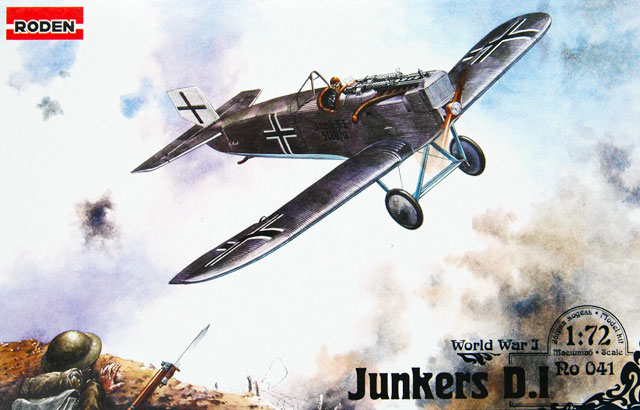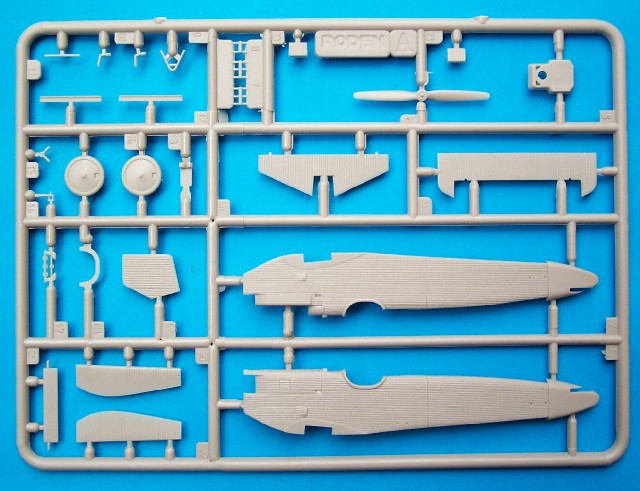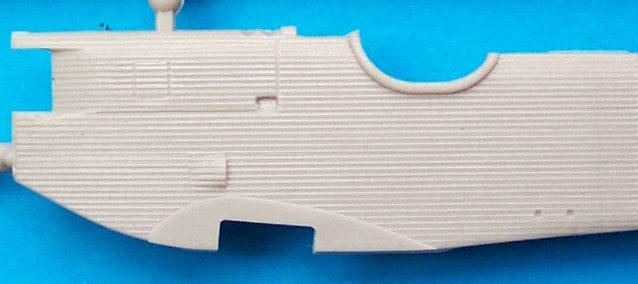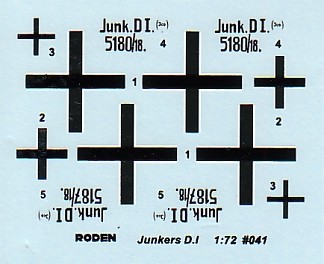|
Junkers D.I
Long Fuselage
Version

Roden 1/72
S
u m m a r y
|
| Catalogue Number: |
Roden 1/72 Junkers D.I (long
fuselage version) Kit #041 |
| Scale: |
1/72 |
| Contents and Media: |
56 parts in injection moulded
plastic; markings for two aircraft |
| Price: |
USD$7.96 from Squadron.com
|
| Review Type: |
FirstLook |
| Advantages: |
Amazing representation of the metal
skin, fine detail, and simple construction |
| Disadvantages: |
|
| Recommendation: |
Highly Recommended |
Reviewed by Robert Baumgartner

Roden's 1/72
scale Junkers D.I is available online from Squadron.com
When others were thinking about wood and fabric,
Professor Hugo Junkers was thinking about metal. His idea of an
all-metal, cantilever-winged aircraft was revolutionary at the time. His
experiments produced the Junkers D.I., which first flew in May 1918.
It was entered in the second Fighter Competition, which also started in
that same month. Despite good flying characteristics, it failed to
impress the Front-line pilots evaluating the machine. This is not
surprising as there was a bias against low wing monoplanes and they
recommended the type as a machine only for attacking observation
balloons. The reason being that its metal construction made it
invulnerable to ground fire.
The D.I did get production orders however, when Idflieg was eventually
convinced of the merits of the project. It is believed that 40 aircraft
were built and that those aircraft that made it to the front had the
shorter fuselage.
Roden's 1/72 scale Junkers D.I Long Fuselage
Version comprises 56 plastic parts contained on three sprues of light
grey plastic.

Click
the thumbnails below to view larger images:
One of these has been seen before and it is the
much-loved sprue Z. It contains the LMG 08/15 machineguns, seat,
Mercedes engine, a spare BMW engine, and a spare parabellum with
ammunition drum.
The sprue has not suffered from its extended use
and the detail remains as delicate and sharp as ever.
The Junkers D.I was built in both long and short fuselage versions.
Roden have decide to do the former and this is found on sprue A. The
representation of the corrugated skin has to be seen to be believed. All
lines are beautifully rendered with a subtlety that really looks good in
this scale.

Structural framework is present on the inside,
which in no way compromises the aforementioned detail with any sink
marks.
The wings continue this high standard on sprue B. The trailing edges are
very thin on all flying surfaces with both elevators and ailerons
supplied as separate pieces. Other items are just as well done and due
to their finesse, should be cleaned up as much as possible while still
on the sprue.
The outlines of the main components compares very favourably when judged
against photographs and Ian Stair’s plans in the “Windsock Datafile” on
the subject.
Assembly should be a breeze due to the simple design of the aircraft
itself. Roden provides the usual necessary components for a basic
cockpit, which can be enhanced if desired. An ejector pin mark is
present in this area but this is essentially hidden when the fuselage is
closed up.
The engine does need a little trimming in the frontal area for it to fit
in the fuselage but this is clearly pointed out in the instructions. The
fuselage is made up in four parts instead of the usual two that
modellers are use to dealing with. A quick dry fit revealed no major fit
problems on my example. Just be sure to take your time and glue small
sections at a time.
There are positive location points for the wings and tailplane so the
rigidity of these items will not be an issue.
A well-printed decal sheet is included that allows
the modeller to choose between two options. The printing was in perfect
register and the images are contained on some very thin carrier film:

1) Junkers D.I. 5180/18
This long fuselage example was the “type –test”
machine that was put through the “non-destructive” procedures at
Adlershof.
The camouflage is believed to be green and
mauve upper surfaces with pale blue under surfaces.
Purists will no doubt add the undercarriage bracing wires that are
not shown in the instructions.
2) Junkers D.I. 5187/18
The instructions illustrate this aircraft in
the familiar irregular pattern of green and mauve upper surfaces
with light blue lower surfaces.
Excellent subject choice from Roden. The almost
non-existent rigging makes this an ideal starter kit for those that
wanting to enter this era of aviation.
Now all we have to do is ask nicely if Roden could produce the short
fuselage version. That way the modeller can represent the machines flown
against the Russian Bolshevik troops in 1919.
Highly Recommended
Thanks to
Squadron.com for the review
sample.
Review and Images Copyright © 2003 by
Robert Baumgartner
Page Created 13 October, 2004
Last updated 13 October, 2004
Back to HyperScale Main Page
Back to Reviews Page
|
Home | What's
New | Features
| Gallery |
Reviews | Reference
| Forum
| Search